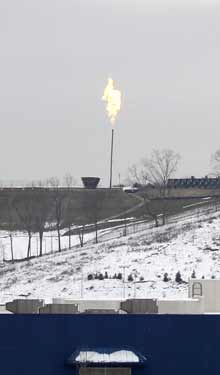Just How Green Is Natural Gas?
Researchers at Cornell University are raising alarms over the expected increase in use of natural gas from shale deposits. They argue that replacing coal and gasoline with natural-gas alternatives could worsen, rather than improve, the impact of greenhouse gases. The greenhouse-gas footprint of shale gas over a 20-year period is at least 20 percent higher than that of coal and “perhaps more than twice as great,” they say in a study published online in the journal Climatic Change. The culprit is the leakage of methane, the main component of natural gas.

To extract natural gas from shale, drillers hydraulically fracture the rock by injecting a cocktail of water and chemicals into a horizontally drilled well at high pressures. Robert Howarth, a biogeochemist and professor of earth sciences at Cornell, argues that a significant amount of gas also mixes with the water-chemical mix and escapes into the atmosphere when the fluid returns to the surface. The drilling out of well plugs that separate fracking stages also results in temporary emission releases, giving shale gas a “significantly larger” greenhouse-gas footprint than conventional natural gas.
The finding is a blow to environmentalists, many of whom have viewed natural gas as a “bridge fuel” on the way to cleaner energy sources. The U.S. Energy Information Administration projects that total U.S. natural-gas production will increase by 20 percent over the next 25 years and that shale gas will account for nearly half of the total, up from 23 percent in 2010. Major U.S. shale deposits include the Marcellus shale formations in the Northeast and the Barnett formations in Texas. China, France, Poland, Chile, and more than a dozen other countries also have significant recoverable shale gas resources, according to a recent Energy Information Administration study.
When burned to generate electricity, natural gas emits roughly half as much carbon dioxide per megawatt-hour as coal. But over its life cycle, natural gas could result in far more greenhouse-gas emissions, whether through intentional venting, equipment leaks, or fracking. And the leaks would consist of methane, which is a much more powerful greenhouse gas than carbon dioxide. The U.S. Environmental Protection Agency conceded in a December report that it had “significantly underestimated” the methane emissions that result from development of unconventional natural-gas resources, primarily shale gas. In some instances, methane emissions were nearly 9,000 times higher than previously thought.
The Cornell researchers acknowledge that the available data is incomplete, and industry groups were quick to counter their conclusions. Energy in Depth, a group representing independent U.S. petroleum producers, accused Howarth of using low-quality data to “jack up” the global-warming potential of methane. It also took issue with his decision to focus on the impacts over 20 years. Howarth, however, says that critical events in climate change are likely to happen in the next two decades, meaning that the short-term impact of methane is an important factor in measuring long-term climate consequences.
On the issue of data quality, Howarth concedes that he didn’t have the best information to work with. “The reason is that all of the data come from industry sources … and industry has not been very forthcoming,” he says, adding that the EPA has proposed regulations that require better reporting on methane leakage. “Were the industry to comply, then more and better documented data could become available, and one could improve on our study.”
Mark Jaccard, a professor of energy and materials research at Simon Fraser University, says he’s not surprised by the findings of the Cornell study. But he suggests that the results are not an argument against shale gas. Instead, the study should be a timely call for stricter regulations. “Shale gas could be produced in a way that had very little emissions,” he says.
Indeed, the Cornell study points to various ways that drillers and pipeline operations could reduce methane emissions by up to 90 percent. But, the study adds, “these technologies are currently not in wide use.”
Keep Reading
Most Popular
Large language models can do jaw-dropping things. But nobody knows exactly why.
And that's a problem. Figuring it out is one of the biggest scientific puzzles of our time and a crucial step towards controlling more powerful future models.
How scientists traced a mysterious covid case back to six toilets
When wastewater surveillance turns into a hunt for a single infected individual, the ethics get tricky.
The problem with plug-in hybrids? Their drivers.
Plug-in hybrids are often sold as a transition to EVs, but new data from Europe shows we’re still underestimating the emissions they produce.
Google DeepMind’s new generative model makes Super Mario–like games from scratch
Genie learns how to control games by watching hours and hours of video. It could help train next-gen robots too.
Stay connected
Get the latest updates from
MIT Technology Review
Discover special offers, top stories, upcoming events, and more.